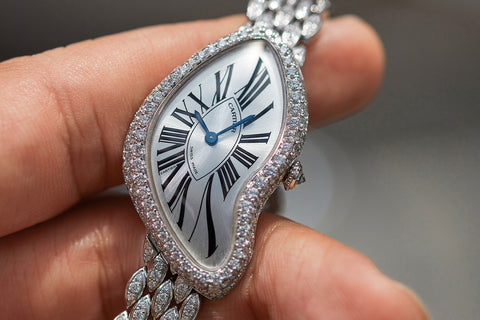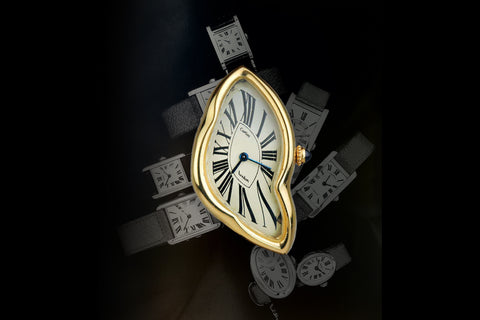The Tortue’s history goes back to 1912, when it was created by Louis Cartier as the brand’s third wristwatch design, following the the Santos Dumont and the Tonneau. Its shape, which is an exaggeration of the tonneau form, came to house a monopusher chronograph as well as a minute repeater in the late 1920s. Both complications were reinterpreted as part of Cartier’s renaissance in the 1990s, in the form of the Collection Privée Cartier Paris.
The CPCP Tortue Minute Repeater, first seen in 2003 was produced in yellow, rose and white gold, with 25 examples produced in each metal. The proportions – 35.5mm across and 43mm tall – were modern yet not a world removed from the original (which measured around 32mm across and 40mm tall). The dial architecture bore the characteristics typical of the CPCP line.
Examples in yellow and rose gold were fitted with the calibre 9401 MC, based on an F. Piguet ébauche. However, the examples produced in white gold wearing the reference 2512C, featured the calibre 909 MC. The two calibres are easily visually distinguished by the construction of the bridges.
This white gold example features the calibre 909 MC, which has independent bridges for the wheels of the going train as well as the escapement. Visible through the display caseback, the movement wears an open layout, with the mainspring and crown wheels not obscured by a bridge, as they are on the calibre 9401 MC. The strike train, responsible for the sonnerie, is also more visible. The hour hammer is immediately adjacent to the balance bridge. North of it lies the minute hammer. Each one interacts with its own gong, producing sounds of different frequencies – the minute hammer produces a higher frequency note while the hour gong produces a lower frequency sound. The resulting sonnerie is subtle but distinct. Also audible is the faint mechanical whir of the strike train.
The calibre 909 MC is also distinct in the nomenclature of the serial number of the watch, detailed as No. XXC. The bridges are decorated with repeating double C brand mark.
The monocoque upper case has a fluid form that appears entirely organic. The edges are soft, with the left flank, and the deep cleft on the left top lug, integrating the stepped slider for the minute repeater. The lugs, 18mm apart, are drilled through, with the strap secured by screwed lugs. The watch comes on an alligator grained rich burgundy leather strap with a white gold deployant clasp. The caseback, secured by four screws, wears engravings detailing the brand mark, country of origin, precious metal hallmarks as well as the reference and serial numbers. Even the angular edges of the crown feature softened edges. It is topped by a sapphire cabochon.
Underneath the heavily domed sapphire crystal – which almost seamlessly meets the curvature of the case – is the dial replete with several CPCP details. Beyond the rose motif around the cannon pinion, roseate guilloche billows across the dial. The outer chapter of black Roman hours is followed by a chemin de fer minutes track. The oversized Cartier Paris mark dominates the top half of the dial. The Breguet hours and minutes hands are heat blued. The subsidiary seconds register is framed by a steel ring followed by a sector-style chemin de fer track and Arabic seconds at intervals of 10. The seconds hand is thin, with a rounded counterweight. It is heat blued.
This example of the CPCP Tortue Minute Repeater reference 2512C is a reference imbued not just with a graceful form but more than a century of history.
If sold within the United Kingdom, this Cartier Tortue Minute Repeater will be subject to 20% VAT


















































































































































































































